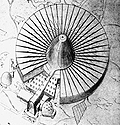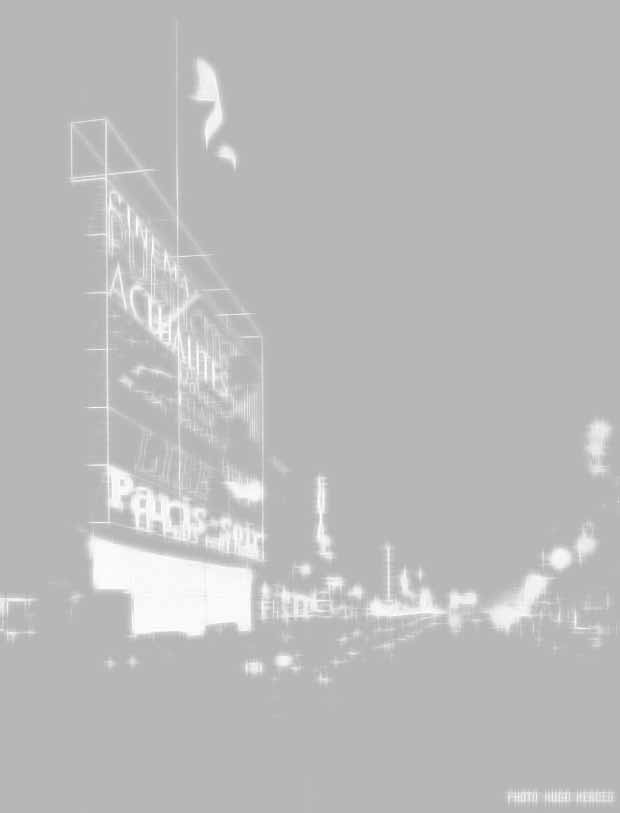 In 1936,
Nelson and Nitzchke would resume their collaboration for the CBS Broadcasting
building competition and the Palais de Decouverte exhibition hall of 1937. Though
Nitzchke would also independantly design a London art school and submit a proposal
for a U.S. elevated highway competition with Vladimir Bodiansky, most of his
final year in Paris was spent working with Nelson and an additional associate
Frantz Jourdain, on the Palace of Decovery.
In 1936,
Nelson and Nitzchke would resume their collaboration for the CBS Broadcasting
building competition and the Palais de Decouverte exhibition hall of 1937. Though
Nitzchke would also independantly design a London art school and submit a proposal
for a U.S. elevated highway competition with Vladimir Bodiansky, most of his
final year in Paris was spent working with Nelson and an additional associate
Frantz Jourdain, on the Palace of Decovery. Around 1935, a group of French scientists under the leadership of Dr. Henri Laugier, organized an exhibition of scientific research for the Exposition Universelle two years later that would inform the public of the new developments of scientific research. Called the Palais de Decouverte, the exhibition was immensely successful during its six month run, despite the fact that it was held in very limited space to the rear of the Grand Palais. Because of its popularity, the scientists became interested in establishing their own separate exhibition building that continue beyond the Exposition. Preliminary sketches had been made by other architects when apparently Christian Zervos asked Nelson if he could undertake the new project without any contract or paid commission. Nelson agreed, interested in the possibility of a new typology and the extensibility requirements of the program, but only on the stipulation that Nitzchke also be taken on as an associate.
Non-architectural planning for the new facility took place under optimal conditions, with the collaboration of eminent scientists Laugier, Perrin, Langevin, Leriche and Plaberenne. Nelson also solicited the cooperation of the museologist George Henri Riviere. From the very first it was agreed that the projected structure would not be a "traditional" museum; lectures would be given there, and there would be a "people's university," which according to Jean Perrin's understanding of the term would "send out its roots among the citizenry of Paris." Such a liberal program, so emblemmatic of era of Leon Blum and the Popular Front--could not fail to interest Nelson. He envisioned a unique facility, independent of existing models and intended to reveal the perpetually evolving relationship of mankind to science.
 The essential
problem of the project, as Nelson would define it, was the extensibility and
flexibility of the new edifice, which only "a new technical architecture" could
resolve: "In order to accomplish this, it was necessary to allow these new functions
to transform themselves in to architecture." Confronted with the complexity
of the program, Nelson applied his three stage method (analysis of requirements,
architectural anaylsis, synthesis through design) and arrived at an "unexpected"
form. Two readable parts can be identified in the structural plan.
The essential
problem of the project, as Nelson would define it, was the extensibility and
flexibility of the new edifice, which only "a new technical architecture" could
resolve: "In order to accomplish this, it was necessary to allow these new functions
to transform themselves in to architecture." Confronted with the complexity
of the program, Nelson applied his three stage method (analysis of requirements,
architectural anaylsis, synthesis through design) and arrived at an "unexpected"
form. Two readable parts can be identified in the structural plan.  The
first is an inclined "parabolic shell," seventy-six meters in diameter and fifty-five
meters high, made of cast concrete. This shell, approached through the parabolic
tunnel serving as an entrance, contains the immense vaulted space where the
visiter views the most impressive scientific displays. The second structural
component is the "flexible ring," a concrete slab surrounding hall, that is
enclosed by a translucent glass strung between stainless steel members, and
suspended from cabling to the parabolic shell. This free-floating ring is intended
for displays about the various disciplines (mathematics, astronomy, physics,
chemistry, biology, medicine) with thirty percent of the surface reserved for
future expansion. In addition to these two main components various service facilities
are grafted along the main axis throughfare, which leads from the entrance hall
to the central hall. These include conference rooms, a cinema, a bookstore,
temporary exhibition space, and administration areas.
The
first is an inclined "parabolic shell," seventy-six meters in diameter and fifty-five
meters high, made of cast concrete. This shell, approached through the parabolic
tunnel serving as an entrance, contains the immense vaulted space where the
visiter views the most impressive scientific displays. The second structural
component is the "flexible ring," a concrete slab surrounding hall, that is
enclosed by a translucent glass strung between stainless steel members, and
suspended from cabling to the parabolic shell. This free-floating ring is intended
for displays about the various disciplines (mathematics, astronomy, physics,
chemistry, biology, medicine) with thirty percent of the surface reserved for
future expansion. In addition to these two main components various service facilities
are grafted along the main axis throughfare, which leads from the entrance hall
to the central hall. These include conference rooms, a cinema, a bookstore,
temporary exhibition space, and administration areas. Abrams has called the Palace of Discovery project a "post-constructivist work that aims to pass beyond the machine esthetic to a tempered, rational expressionism." [18] Indeed the Palais is the most lyrical and expressive of all the Nelson/Nitzchke work done during the thirties, with the vivid functionalism and tempered plasticity contained to specific segments in the earlier buildings here subsuming the entire complex.
The earlier strategies Nelson and Nitzchke had employed--the "free section," grafting, the use of both tensile and compressive support systems, the compressed plasticity of plan -- are all used in the Palais de Decouverte but without the usual level of Perret-inspired restraint. There appear to be two reasons to explain this. Nelson, at Leger and Miro's prodding, had resumed painting in the late thirties and had taken on the "post-cubist" biomorphism popular at the time. Nelson may have been inspired through his paintings to launch off to a more expressive level in his architecture.
 In
the thirties, Schaller de Lubicz developed theories on ancient Egyptian architecture
that proposed that Egyptian temple design was in fact inspired by human physionomy
studies of the brain that early Egyptian priests had developed. Though his book
The Temple in Man: The Secrets of Ancient Egypt would not be published until
the forties, it is conceivable that Nelson knew of the work through published
articles. What makes the connection so viable is the explicit Medamud reference
and the odd similaries between the plan of the Palais de Decouverte and brain
cross-sections Schaller de Lubicz related to the plan design of the Temple of
Luxor. It is conceivable that in seeking to express the "new monumentality "
of a technological civilization perpetually expanding in its knowledge, Nelson
found the most appropriate allusion in the human brain itself.
In
the thirties, Schaller de Lubicz developed theories on ancient Egyptian architecture
that proposed that Egyptian temple design was in fact inspired by human physionomy
studies of the brain that early Egyptian priests had developed. Though his book
The Temple in Man: The Secrets of Ancient Egypt would not be published until
the forties, it is conceivable that Nelson knew of the work through published
articles. What makes the connection so viable is the explicit Medamud reference
and the odd similaries between the plan of the Palais de Decouverte and brain
cross-sections Schaller de Lubicz related to the plan design of the Temple of
Luxor. It is conceivable that in seeking to express the "new monumentality "
of a technological civilization perpetually expanding in its knowledge, Nelson
found the most appropriate allusion in the human brain itself. The 1937 Exposition Universelle is rightly seen by some as the last time that the optimistic modernity of the interwar years would be presented to a European public. The popularity of Corbusier's Temps Nouveau edifice as well as the prgressive Czech and Finnish pavilions makes this clear. But the stern monumental 'face-off' between Speer's German pavilion and Yofan's pavilion for the USSR forbodes the harsh future and reveals just how styistic and petrified along political lines European architecture was becoming in the late 30's. Like the Maison de Peuple built in Clichy by the team of Baudoin, Lods, and Prouve later that year, the unbuilt Palace of dicovery was concerned with program, flexibility and human need. Ironically , this focus seems suddenly incongruous amid the warped semiotic struggles of Speer and Yofan, totalitarian architects each vying for the 'soul of European civilization.'
[CONTINUE] Coda: The end of the partnership and the larger eclipse of the Parisian sensibility
zones |
-
RETURN|
BASILISK
MORE | COMPOSITE MODERNISM
PREVIOUS | COMPOSITE MODERNISM 6
NEXT | COMPOSITE MODERNISM 8
